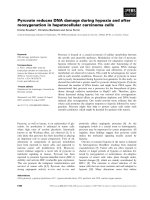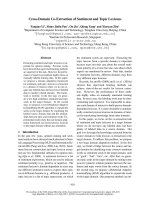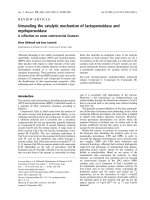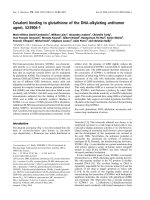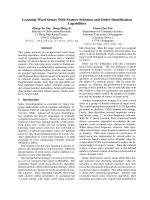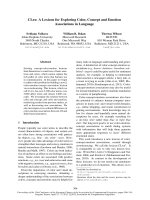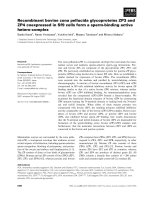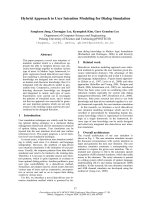báo cáo khoa học: "Biotechnology approach to determination of genetic and epigenetic control in cells" pdf
Bạn đang xem bản rút gọn của tài liệu. Xem và tải ngay bản đầy đủ của tài liệu tại đây (3.65 MB, 10 trang )
BioMed Central
Page 1 of 10
(page number not for citation purposes)
Journal of Nanobiotechnology
Open Access
Review
Biotechnology approach to determination of genetic and epigenetic
control in cells
Kenji Yasuda*
Address: Department of Life Sciences, Graduate school of Arts and Sciences, University of Tokyo, 3-8-1 Komaba, Meguro, Tokyo 153-8902 JAPAN
Email: Kenji Yasuda* -
* Corresponding author
Abstract
A series of studies aimed at developing methods and systems for analyzing epigenetic information
in cells are presented. The role of the epigenetic information of cells, which is complementary to
their genetic information, was inferred by comparing the predictions of genetic information with
the cell behaviour observed under conditions chosen to reveal adaptation processes and
community effects. Analysis of epigenetic information was developed starting from the twin
complementary viewpoints of cells regulation as an 'algebraic' system (emphasis on the temporal
aspect) and as a 'geometric' system (emphasis on the spatial aspect). The knowlege acquired from
this study will lead to the use of cells for fully controlled practical applications like cell-based drug
screening and the regeneration of organs.
Review
1. General background
Knowledge about living organisms increased dramatically
during the 20th century and has produced the modern
disciplines of genomics and proteomics. Despite these
advances, however, there remains the great challenge of
learning how the different living components of the cell
are integrated and regulated. As we move into the post-
genomic period, the complementarity of genomics and
proteomics will become apparent and the connections
between them will be exploited. However, neither genom-
ics nor proteomics alone can provide the knowledge
needed to interconnect the molecular events in living
cells. The cells in a group are individual entities, and dif-
ferences arise even among cells with identical genetic
information that have grown under the same conditions.
These cells respond to perturbations differently. Why and
how do these differences arise? Cells are the minimum
units containing both genetic and epigenetic information
which are used in response to environmental conditions
such as interactions between neighbouring cells and of
changes in extracellular conditions. To understand the
rules underlying the possible differences occurring in
cells, we need to develop methods for simultaneously
evaluating both the genetic information and the epige-
netic information (Fig. 1). In other words, if we are to
understand adaptation processes, community effects, and
the meaning of network patterns of cells, we need to ana-
lyze the epigenetic information in cells. Thus we have
started a project focusing on developing a system that can
be used to evaluate the epigenetic information of cells by
observing specific cells and their interactions continu-
ously under controlled conditions. The importance of the
understanding of epigenetic information will become
apparent in cell-based biological and medical fields like
cell-based drug screening and the regeneration of organs
from stem cells, fields in which phenomena cannot be
interpreted without taking epigenetic factors into account.
Published: 22 November 2004
Journal of Nanobiotechnology 2004, 2:11 doi:10.1186/1477-3155-2-
11
Received: 21 December 2003
Accepted: 22 November 2004
This article is available from: />© 2004 Yasuda; licensee BioMed Central Ltd.
This is an Open Access article distributed under the terms of the Creative Commons Attribution License ( />2.0), which permits unrestricted use, distribution, and reproduction in any medium, provided the original work is properly cited.
Journal of Nanobiotechnology 2004, 2:11 />Page 2 of 10
(page number not for citation purposes)
In 1999 the author moved to the Univ. of Tokyo and
began his research on the "determination of genetic and
epigenetic cellular control processes". To understand the
meaning of the genetic variability and the epigenetic cor-
relation of cells, we have developed the on-chip single-
cell-based microcultivation method. As shown in Fig. 2,
the strategy consists of a three step process. First we purify
cells from tissue individually in a nondestructive manner.
[1] Then we cultivate the cells and observe them under
fully controlled conditions (e.g., cell population, network
pattern, or nutrient conditions) by using the on-chip sin-
gle-cell cultivation chip [2-10] or by using an on-chip aga-
rose microchamber system [11-14]. Finally, we do a
single-cell-based expression analysis using the photother-
mal denaturation method and a single-molecule level
analysis [15]. In this way, we can control the spatial distri-
bution and interactions of cells.
2. Aim of the project
The aim of our project is to develop methods and systems
for analyzing the epigenetic information in cells. The
project is based on the idea that, although genetic infor-
mation makes a network of biochemical reactions, the
history of the network as a parallel-processing recurrent
network was ultimately determined by the environmental
conditions of cells, which we call epigenetic information.
As described above, if we are to understand the events in
living systems at the cellular level, we need to keep in
mind that epigenetic information is complementary to
genetic information.
The advantage of this approach is that it bypasses the com-
plexity of underlying physicochemical reactions which are
not always completely understood and for which most of
the necessary variables cannot be measured. Moreover,
this approach shifts the view of cell regulatory processes
from the basic chemical ground to the paradigm of a cell
as an information-processing unit working as an
intelligent machine capable of adaptation to changing
environmental and internal conditions. It is an alternative
representation of the cell and can bring new insight into
cellular processes. Moreover, models derived from such a
viewpoint can directly help in the more traditional bio-
chemical and molecular biological analyses of cell
control.
The basic part of the project is the development of on-chip
single-cell-based cultivation and analysis systems for
monitoring the dynamic processes in the cell. In addition
we have employed these systems to examine a number of
other processes eg; the variability of cells having the same
genetic information, the inheritance of non-genetic infor-
mation between adjacent generations of cells, the cellular
adaptation processes caused by environmental change,
the community effect of cells and network pattern forma-
tion in cell groups (Figs. 3 and 4). After making extensive
experimental observations, we can understand the mean-
ing of epigenetic information in the modeling of more
complex signaling cascades. This field has been largely
monopolized by physico-chemical models, which pro-
vide a good standard for the comparison, evaluation, and
development of our approach. The ultimate aim of our
project is to provide a comprehensive understanding of
living systems as the products of both genetic information
and epigenetic information.
3-1. Single-cell cultivation chip system [2-10]
To understand the variability of cells having the same
genetic information and to observe the adaptation proc-
esses of cells, we need to compare the sister cells or the
direct descendant cells directly (Fig. 3). For that purpose,
we have developed the system for an on-chip single-cell
cultivation chip. The system enables excess cells to be
transferred from the analysis chamber to the waste cham-
ber through a narrow channel and allows a particular cell
to be selected from the cells in the microfabricated culti-
vation chamber by using a kind of non-contact force, opti-
cal tweezers (Fig. 5). Figure 6 depicts our entire system for
the on-chip single-cell microculture chip. The system con-
sists of a microchamber array plate, a cover chamber, a
phase-contrast/fluorescent microscope and optical tweez-
ers. The cover chamber is a glass cube filled with a buffer
medium and is attached to the array plate so that the
medium in the microchambers can be exchanged through
a semipermeable membrane.
Using the system, we examined whether the direct
descendants of an isolated single cell could be observed
under the same isolation conditions. Figure 7(a) plots the
variations in interdivision times of consecutive genera-
Epigenetic information: complementary to genetic informationFigure 1
Epigenetic information: complementary to genetic
information.
Journal of Nanobiotechnology 2004, 2:11 />Page 3 of 10
(page number not for citation purposes)
Our strategy: on-chip single-cell-based analysisFigure 2
Our strategy: on-chip single-cell-based analysis.
Aim of our project (1): temporal aspectFigure 3
Aim of our project (1): temporal aspect.
Aim of our project (2): spatial aspectFigure 4
Aim of our project (2): spatial aspect.
Journal of Nanobiotechnology 2004, 2:11 />Page 4 of 10
(page number not for citation purposes)
tions of isolated E. coli cells derived from a common
ancestor. The four series of interdivision times varied
around the overall mean value, 52 min (dashed line); the
mean values of the four cell lines a, b, c, and d were 54,
51, 56 and 56 min, showing differences rather small com-
pared with the large variations in the interdivision times
of consecutive generations. This result supports the idea
that interdivision time variations from generation to gen-
eration are dominated by fluctuations around the mean
value, and it was evidence of a stabilized phenotype that
was subsequently inherited. To explore this idea, we
examined the dependence of interdivision time on the
interdivision time of the previous generation. We grouped
the interdivision time data into four categories and deter-
mined their distributions (Fig. 7(b)). Comparison of
these distributions showed that they were astonishingly
similar to one other, suggesting that there was no
dependence on the previous generation. That is, there was
no inheritance in interdivision time from one generation
to the next.
3-2. On-chip agarose microchamber system [11-14]
One approach to study network patterns (or cell-cell inter-
actions) and the community effect of cells is to create a
fully controlled network by using cells on the chip (Fig.
4). We have therefore developed a system consisting of an
agar-microchamber (AMC) array chip, a cultivation dish
with a nutrient-buffer-changing apparatus, a permeable
cultivation container, and a phase-contrast/fluorescent
optical microscope with a 1064-nm Nd:YAG focused laser
irradiation apparatus for photothermal spot heating (Fig.
8). The most important advantage of this system is that we
can change the microstructures in the agar layer even dur-
ing cultivation, which is impossible when using conven-
Single-cell cultivation in microchambers for measuring the variability of genetic informationFigure 5
Single-cell cultivation in microchambers for measuring the variability of genetic information.
Journal of Nanobiotechnology 2004, 2:11 />Page 5 of 10
(page number not for citation purposes)
tional Si/glass-based microfabrication techniques and
microprinting methods.
As explained above, the agarose-microchamber cell-culti-
vation system includes an apparatus for photothermal
etching. Photothermal etching is an area-specific melting
of the agarose microchambers by spot heating using a
focused laser beam and a thin layer made of a light-
absorbing material such as chromium (since agarose itself
has little absorbance at 1064-nm). We made the three-
dimensional structure of the agar microchambers by using
a photo-thermal etching module. Figure 9 is a top-view
micrograph of the agar microchambers connected by
small channels. The space on the chip was colored by fill-
ing the microchambers with a fluorescent dye solution.
Also shown are cross-sectional views of the A-A and B-B
sections, in which we can easily see narrow tunnels under
the thick agar layer in the A-A section and round tunnels
in the B-B section. These cross-sectional micrographs
show that we can make narrow tunnels in the agar layer by
photothermal etching. The left micrograph in Fig. 9 is a
top view of the whole microchamber array connected by
narrow tunnels.
By using this photothermal etching method, we can
change the neural network pattern on a multi-electrode
array chip during cultivation. Figure 10 shows the time
course of the axon growth of rat hippocampal cells. After
5 days of cultivation (5DIV), when the cells in six micro-
chambers had been connected by axons grown through
the four existing tunnels (arrows in Figs. (a) and (b)), two
new tunnels (arrows in Figs. (c) and (d)) were created by
photothermal etching. After five more days of cultivation
(10DIV), connecting axons had grown through them as
well.
The agarose microchamber system can also be used to
observe the dynamics of the synchronizing process of two
isolated rat cardiac myocytes. Figure 11 shows an example
of the synchronizing process of two cardiac myocytes.
After the cultivation had begun, the two cells elongated
and made physical contact within 24 hours, followed by
System for on-chip single-cell microculture chipFigure 6
System for on-chip single-cell microculture chip.
Journal of Nanobiotechnology 2004, 2:11 />Page 6 of 10
(page number not for citation purposes)
synchronization. It should be noted that, as shown in the
graph, the synchronization process involved one of the
cells following the rhythm of the other, and that the 'copy
cat' cell stops beating prior to acquiring the new beat
rhythm.
Conclusions
We have newly developed and have just started to use a
series of methods for understanding the meaning of
genetic information and epigenetic information in a
simple cell model system. The most important expected
contribution of this project is to reconstruct the concept of
a cell regulatory network from the 'local' (molecules
expressed at certain times and places) to the 'global' (the
cell as a viable, functioning system). Knowledge of epige-
netic information, which we can control and change
during their life, is complementary to genetic
information, and those two kinds of information are
indispensable for living organisms. This new kind of
knowlege has the potential to be the basis of a new field
of science.
Authors' contributions
KY conceived of the study, its design and coordination.
Genetic variability of direct descendant cells of E. coliFigure 7
Genetic variability of direct descendant cells of E. coli.
Journal of Nanobiotechnology 2004, 2:11 />Page 7 of 10
(page number not for citation purposes)
On-chip agarose microchamber systemFigure 8
On-chip agarose microchamber system.
Three-dimensional structure of agarose microstructuresFigure 9
Three-dimensional structure of agarose microstructures.
Journal of Nanobiotechnology 2004, 2:11 />Page 8 of 10
(page number not for citation purposes)
Stepwise formation of neuronal network of rat hippocampal cellsFigure 10
Stepwise formation of neuronal network of rat hippocampal cells.
Journal of Nanobiotechnology 2004, 2:11 />Page 9 of 10
(page number not for citation purposes)
Dynamics of the synchronizing process of two isolated rat cardiac myocytesFigure 11
Dynamics of the synchronizing process of two isolated rat cardiac myocytes.
Publish with BioMed Central and every
scientist can read your work free of charge
"BioMed Central will be the most significant development for
disseminating the results of biomedical research in our lifetime."
Sir Paul Nurse, Cancer Research UK
Your research papers will be:
available free of charge to the entire biomedical community
peer reviewed and published immediately upon acceptance
cited in PubMed and archived on PubMed Central
yours — you keep the copyright
Submit your manuscript here:
/>BioMedcentral
Journal of Nanobiotechnology 2004, 2:11 />Page 10 of 10
(page number not for citation purposes)
Acknowledgements
The author thanks all the members in Yasuda Lab and collaborators for this
project.
References
1. Yasuda K: Non-destractive, non-contact handling method for
biomaterials in micro-chamber by ultrasound. Sensors and
Actuators B 2000, 64:128-135.
2. Inoue I, Wakamoto Y, Moriguchi H, Okano K, Yasuda K: On-chip
culture system for observation of isolated individual cells. Lab
Chip 2001, 1:50-55.
3. Wakamoto Y, Inoue I, Moriguchi H, Yasuda K: Analysis of single-
cell differences using on-chip microculture system and opti-
cal trapping. Fresenius J Anal Chem 2001, 371:276-281.
4. Inoue I, Wakamoto Y, Yasuda K: Non-genetic variability of divi-
sion cycle and growth of isolated individual cells in on-chip
culture system. Proc Japan Acad 2001, 77B:145-150.
5. Umehara S, Wakamoto Y, Inoue I, Yasuda K: On-chip single-cell
microcultivation assay for monitoring environmental effects
on isolated cells. Biochem Biophys Res Commun 2003, 305:534-540.
6. Matsumura K, Yagi T, Yasuda K: Role of Timer and Sizer in Reg-
ulation of Chlamydomonas Cell Cycle. Biochem Biophys Res
Commun 2003, 306:1042-1049.
7. Matsumura K, Yagi T, Yasuda K: Differential analysis of cell cycle
stability in Chlamydomonas using on-chip single-cell cultiva-
tion system. Jpn J Appl Phys 2003, 42:L784-L787.
8. Hattori A, Umehara S, Wakamoto Y, Yasuda K: Measurement of
incident angle dependence of swimming bacterium reflec-
tion using on-chip single-cell cultivation assay. Jpn J Appl Phys
2003, 42:L873-L875.
9. Wakamoto Y, Umehara S, Matsumura K, Inoue I, Yasuda K: Devel-
opment of non-destructive, non-contact single-cell based dif-
ferential cell assay using on-chip microcultivation and optical
tweezers. Sensors and Actuators B 2003, 96:693-700.
10. Takahashi K, Matsumura K, Yasuda K: On-chip microcultivation
chamber for swimming cells using visualized poly(dimetylsi-
loxane) valve. Jpn J Appl Phys 2003, 42:L1104-L1107.
11. Moriguchi H, Wakamoto Y, Sugio Y, Takahashi K, Inoue I, Yasuda Y:
An agar-microchamber cell-cultivation system: flexible
change of microchamber shapes during cultivation by photo-
thermal etching. Lab Chip 2002, 2:125-30.
12. Sugio Y, Kojima K, Moriguchi H, Takahashi K, Kaneko T, Yasuda K:
An agar-based on-chip neural-cell cultivation system for
stepwise control of network pattern generation during
cultivation. Sensors & Actuators B 2002 in press.
13. Moriguchi H, Takahashi K, Sugio Y, Wakamoto Y, Inoue I, Jimbo Y,
Yasuda K: On chip neural cell cultivation using agarose-micro-
chamber array constructed by photo-thermal etching
method. Electrical Engineering in Japan 2003, 146:37-42.
14. Kojima K, Moriguchi H, Hattori A, Kaneko T, Yasuda K: Two-
dimensional network formation of cardiac myocytes in agar
microculture chip with 1480-nm infrared laser photo-ther-
mal etching. Lab Chip 2003, 3:299-303.
15. Yasuda K, Okano K, Ishiwata S: Focal extraction of surface-
bound DNA from a microchip using photo- thermal
denaturation. Biotechniques 2000, 28:1006-1011.
